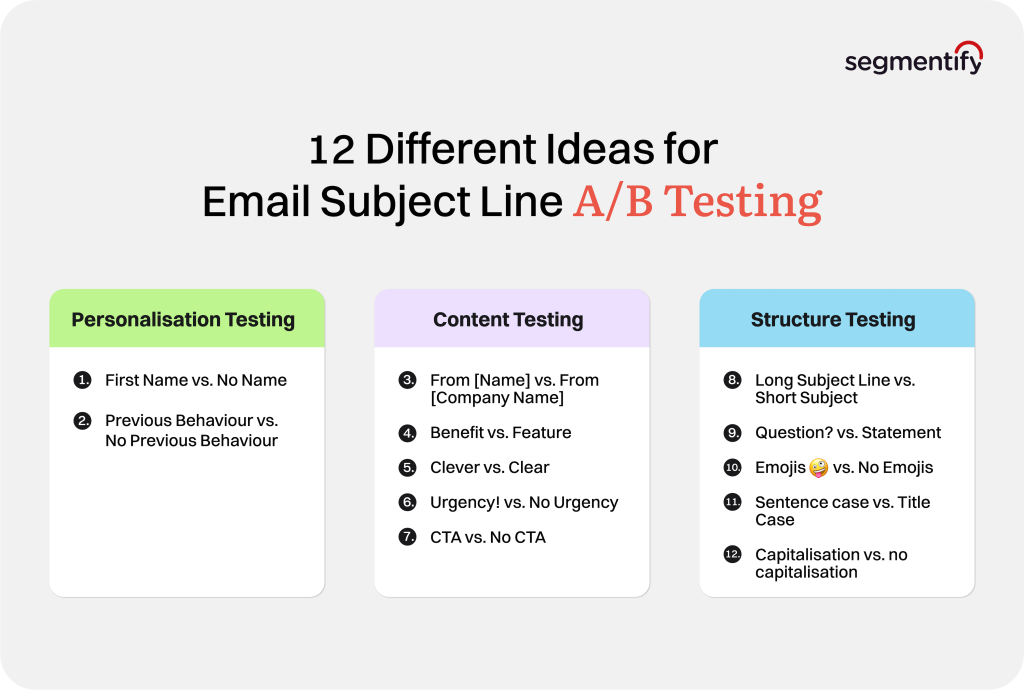Our websites use cookies. By continuing, we assume your permission to deploy cookies as detailed in our Privacy Policy.
Email Subject Line A/B Testing Best Practices
Ahh, the subject line…
The first impression, the battle cry that cuts through the noise and determines whether your message gets heard or deleted in a ruthless swipe…
While some might find the art of email subject lines elusive and challenging, you should know that you have nothing to be afraid of—as long as you A/B test.
This guide will equip you with 12 powerful A/B testing strategies to optimise your subject lines, along with crucial tips to ensure your tests deliver valuable insights. So buckle up and get ready to craft subject lines that turn email marketing from a guessing game into a guaranteed win!
Why You Need to Run Subject Line Tests
Ever heard the saying, “You never get a second chance to make a first impression”?
The same goes for email subject lines. An email’s subject line is the first impression that convinces subscribers to open your message. In fact, 64% of email recipients open emails based on the subject lines alone.
That’s why A/B testing your subject lines is crucial. A/B testing involves sending two different versions of your email to similar groups of subscribers and seeing which one improves certain email marketing metrics like opens, clicks, or conversions.
Here’s how subject line testing can boost your email marketing:
- Higher open rates: Winning subject lines grab attention and entice people to open your email, leading to more clicks and conversions.
- Improved click-through rates (CTRs): Strong subject lines set the stage for a compelling email, increasing the chances of users clicking on your call to action.
- Better conversions: Ultimately, subject line testing helps you craft emails that drive more sales, signups, or whatever your marketing goals may be.
12 Ways You Can Test Email Subject Lines
Crafting the perfect email subject line is an art and a science. To truly understand what resonates with your audience, A/B testing is crucial.
Here, we explore 12 creative ways to test your subject lines, categorised into three key areas: Personalisation, Content, and Structure. Let’s dive right in!

Personalisation Testing
Let’s delve into the world of personalisation testing! Here, we’ll explore two methods to see if tailoring your subject line to specific subscribers yields better results:
1. First Name vs. No Name: Personalisation is a powerful tool in email marketing, but is a first name in the subject line always the best approach? Split testing “Hi [Name], Unlock the Secrets of A/B Testing!” vs. “How to Craft Winning Email Subject Lines with A/B Testing” will let you uncover if this type of email personalisation works on your subscribers.
2. Previous Behaviour vs. No Previous Behaviour: Segmentation based on past actions and tailoring subject lines based on this can significantly impact engagement. Subject lines that speak directly to a subscriber’s past behaviour or interests can feel more relevant and, hence, lead to higher open rates. More generic subject lines, on the other hand, might be suitable for initial outreach or reaching a broader audience segment.
Content Testing
Now, let’s shift gears and focus on the content itself within your subject line. Here, we’ll explore several A/B testing ideas to see which elements resonate most with your subscribers:
3. From [Name] vs. From [Company Name]: Who should your emails be “from”? Experiment with the sender name, considering the audience type. In B2B communication, a specific contact name (e.g., Sarah at [Company Name]) can feel more approachable. For B2C audiences, your company name itself (e.g., From [Company Name]) might be more familiar and trustworthy.
4. Benefit vs. Feature: Subject lines highlighting the “why” can be more impactful than simply stating the “what”, but there’s only one way to find out. Benefit-driven subject lines focus on the positive outcome subscribers gain from opening the email (e.g., “Unlock Higher Click Rates with Our New Email Design Tools ”). Feature-focused lines highlight a specific aspect or functionality the email content offers (e.g., “New Email Design Tools Available Now!”).
5. Clever vs. Clear: Clever subject lines can grab attention in crowded inboxes but might not always convey the email’s value. So, should your subject lines be witty and attention-grabbing (“Subject Line A/B Testing: From Bland to Grand”) or clear and informative (“Boost Opens: Master Subject Line A/B Testing”)? You know what to do to find this out!
6. Urgency! vs. No Urgency: Urgency can trigger FOMO (fear of missing out), potentially leading to higher open rates for time-sensitive offers or valuable information. However, you don’t always need urgency (Ever heard of the boy who cried wolf?). Test “Last Chance! A/B Testing Secrets Revealed” vs. “The Ultimate Guide to A/B Testing Email Subject Lines” to see if you need to emphasise urgency.
7. CTA vs. No CTA: Should your subject line explicitly tell subscribers what to do next? A/B testing “CTA vs. No CTA” helps determine if a clear call to action (CTA) influences open rates. No CTA builds intrigue but might not be as action-oriented (e.g., “Download Your Free A/B Testing Guide Now” vs. “A/B Testing: The Secret Weapon for Higher Email Engagement”)
Structure Testing
Beyond personalisation and content, the structure of your subject line also plays a crucial role in grabbing attention. Let’s explore A/B testing ideas that focus on how you present your message:
8. Long Subject Line vs. Short Subject: Long lines offer more context, but short lines ensure mobile visibility. Since mobile dominates as the preferred reading environment with 44.7% and has limited screen space, testing the subject line lengths can make huge differences in email open rates.
9. Question? vs. Statement: Well-crafted questions can pique interest and encourage engagement. A/B testing “How to Split Test Email Subject Lines” vs. “Struggling with Email Marketing? How to Split Test for Success” can reveal if curiosity translates to opens.
10. Emojis 🤪 vs. No Emojis: Emojis can add a touch of personality and fun to your email subject lines, but are they always the right choice? This would depend on your audience’s psyche, devices, and overall context. Since their overuse can appear unprofessional, do split tests to understand your audience’s reaction.
11. Sentence case vs. Title Case: Even a minor detail like subject line capitalisation can affect open rates. Using the sentence case creates a casual, conversational tone, while the title case feels more formal and authoritative. By monitoring “How to A/B test email subject lines” vs. “How to A/B Test Email Subject Lines”, you can determine which capitalisation resonates with your audience.
12. Capitalisation vs. no capitalisation: While it might seem unconventional, ditching capitalisation altogether can yield interesting results. Yes, no caps feels informal but you can’t deny that it does stand out in an inbox. Try A/B testing “Time to Learn How to A/B Test Subject Lines!” vs “time to learn how to a/b test subject lines”, especially if your audience is on the younger side.
Email Subject Line A/B Testing Best Practices
Here’s how to ensure your subject line A/B tests deliver clear results and optimise your email marketing:
- Isolate the test variable: Test only one element at a time (e.g., first name vs. no first name) to isolate which change drives better results. This makes it easier to analyse the impact and refine future tests.
- Test with purpose: Don’t run A/B tests mindlessly. Always have a clear hypothesis behind each test variation. What are you hoping to learn about your audience? This focused approach helps you understand what resonates with them.
- Maintain consistent timing & frequency: Don’t introduce additional variables. Send test emails to similar groups on the same day and time to ensure a fair comparison.
- Sample size matters: Ensure sufficient subscribers receive each test variant. This allows for statistically significant results, meaning the winner is truly the better performer, not just a random fluctuation.
- Find the optimal test duration: Run your tests long enough to gather enough data but not so long that the content becomes outdated. Aim for a timeframe that reflects your typical email frequency (e.g., a week for a daily email campaign).
- Embrace continuous optimisation: Analyse your results, identify the winning subject line, and understand why it performed better. Use these learnings to inform future subject line creation and keep optimising your email marketing efforts.
Subject Line Testing is An Ongoing Process
Don’t feel overwhelmed by the 12 A/B testing ideas presented here.
Start with a few that align with your audience and campaign goals. As you gather data and witness the power of these tests, you can gradually explore additional strategies.
Subject line optimisation is a continuous journey, not a one-time fix. By embracing A/B testing and iterating based on results, you’ll refine your subject lines into captivating first impressions that unlock inbox dominance and propel your email marketing to new heights.
So, buckle up, experiment, and enjoy the ride!





